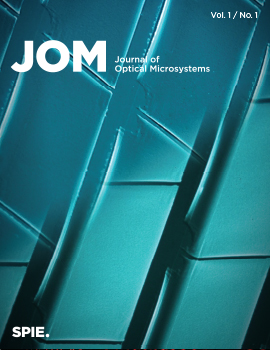Tomotaka Asari, Mamoru Miyachi, Yutaro Oda, Takaaki Koyama, Hiroaki Kurosu, Makoto Sakurai, Masanao Tani, Yoshiaki Yasuda, Hiroshi Toshiyoshi
Journal of Optical Microsystems, Vol. 1, Issue 01, 014501, (January 2021) https://doi.org/10.1117/1.JOM.1.1.014501

TOPICS: Microelectromechanical systems, Optical scanning, Headlamps, Scanners, Ferroelectric materials, Actuators, Mirrors, Silicon, Electrodes, Light sources and illumination
An adaptive driving beam (ADB) for vehicle headlights has been developed using a microelectromechanical systems optical scanner. A piezoelectric scanner is constructed using thin-film lead-zirconate-titanate oxide (PbZrTiO3, PZT) on a bonded silicon-on-insulator (SOI) wafer, respectively, processed by ion-milling and deep reactive ion etching. The PZT layer is laminated in metal films on the SOI layer to form a piezoelectric unimorph actuator, which are then arranged as a pair of twisting suspensions to drive the scanner at resonance. The same piezoelectric actuators are also arranged into another form of meandering suspensions to generate a large deflection angle. By the combination of these two mechanisms, two-dimensional optical scanner is constructed in a single chip. The scanner is used to draw a Lissajous pattern of a blue laser light on a phosphor material to create a structured light source that is projected forward for illumination. The lighting patterns and positions are electronically controlled and reconfigured depending upon the location of leading/oncoming vehicles, pedestrians, road signs, and the cruising speed of the vehicle. The paper discusses on the design of the piezoelectrically driven optical scanner along with the optomechanical performances. We also report on the road-test result of the developed on-vehicle ADB module.



 Receive Email Alerts
Receive Email Alerts